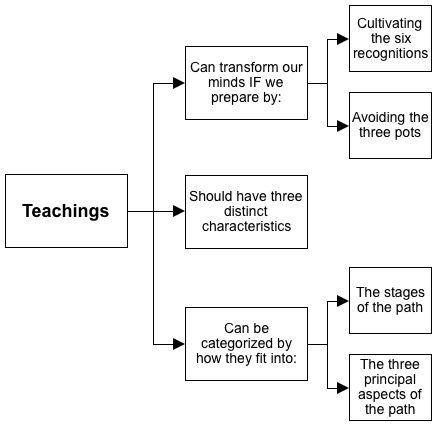Teachings
Preparing Our Minds for Teachings
To prepare our minds for teachings:
- Think about the benefits of listening:
- We learn how to meditate effectively.
- We learn to discriminate between constructive and destructive thoughts and emotions.
- We learn how to counteract our disturbing attitudes and how to increase our good qualities.
- Realize that the Dharma we hear becomes our best friend and our most reliable companion.
- Nobody can take it away from us.
- No adverse circumstances can keep us from practicing.
- Even at the time of death, we’ll know how to work constructively with our mind.
- Remember that we need to make the best use of this precious human life.
- Realize that the teachings will bring about an inner transformation if we approach them in a constructive way, i.e., if we avoid three faults (the three pots) and foster six attitudes (the six recognitions).
The Three Pots Analogy
It’s important to listen to and study the Dharma with the correct attitude and in a beneficial way. Don’t be like the three kinds of pots:
- The upside-down pot: Nothing gets in because we’re asleep or distracted.
- The pot with the hole in the bottom: We’re awake, we’re listening, but we can’t remember what was said.
- Take notes during or immediately after teachings.
- Review, highlighting main points.
- The dirty pot: Even if you pour in something pure, it gets polluted.
- Ex: We come, we listen, but our motivation is polluted by any of the three poisons, by the eight worldly concerns, or by being concerned only with the well-being of this life.
- Ex: We come because we enjoy criticizing others’ views.
- The best motivation is the desire to transform your own mind.
To counteract these faults:
- Listen attentively to teachings.
- Try to recall what you have heard repeatedly.
- Remind yourself to arouse a pure intention, e.g., the wish to be free from cyclic existence or to attain enlightenment for the benefit of all.
- Cultivate the six recognitions.
The Six Recognitions
Listening to teachings with the six recognitions helps us to set our minds and motivations.
- See ourselves as a sick person.
- Our mind is sick with the illness of ignorance, anger, and attachment.
- Our body is sick by being under the influence of those three poisonous attitudes.
- We’re sick because, under the influence of ignorance and karma, we take one rebirth after another without finding lasting happiness.
- We’re sick because our mind does not see reality; we live in confusion.
- We need to see ourselves as ailing to generate real motivation for hearing the teachings.
- See the teacher as a skilled doctor.
- Ultimately, the Buddha is our real teacher.
- He diagnoses our disease (we suffer from cyclic existence) and prescribes medicine (the three higher trainings and the development of bodhicitta).
- See the Dharma as medicine.
- We have to take the medicine in order to be cured.
- The Dharma medicine will stop our unhappiness, clear our confusion.
- Practice the Dharma in order to be cured.
- We need to actually contemplate and practice what we hear.
- We need to take the full course of treatment, i.e., continue to practice, so the medicine has a lasting effect.
- See the Buddha as a holy being whose Dharma medicine is not deceptive.
- We trust the Buddha as non-deceptive because he described the path that he himself followed.
- He didn’t make up the Dharma; he just realized what needs to be abandoned and what needs to be practiced, and then he did it.
- He actualized this through his own experience and he taught others with the motivation of compassion.
- Pray that the teachings and methods we learn will exist and flourish in the world forever. That way, others can benefit for many years to come.
Three Distinguishing Characteristics of Teachings
The teachings we should listen to and practice have three distinguishing characteristics:
- They have been taught by the Buddha.
- The Buddha described the path based on his own experience and did it with a motivation of compassion.
- They are clean of any errors.
- Sometimes over the centuries, things get corrupted or misinterpreted.
- Sometimes cultural practices sneak into the Dharma.
- We want to make sure that the teachings we hear can be traced back to the sutras and the Buddha’s words.
- They have been realized by the great masters.
- Teachings must be passed to us through the various generations of an unbroken lineage.
- Not only the teachings but also the realizations of the teachings have been preserved.
- When we meet a practitioner who has transformed his/her mind through the practice, we know these teachings really do work.
Explaining and Teaching the Dharma
Thinking about the benefits of teaching can encourage us to see the value of what we do.
- The gift of the Dharma is the highest gift, the greatest kindness.
- When you teach, you also have to practice what you teach.
- Just as students should check out the qualities of a teacher, teachers should check out the qualities of students; different audiences may bring out different kinds of teachings.
The Diagram
